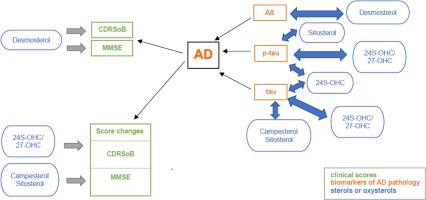The Journal of Steroid Biochemistry and Molecular Biology ( IF 4.1 ) Pub Date : 2020-11-07 , DOI: 10.1016/j.jsbmb.2020.105785 Tabea Jahn , Christopher Clark , Anja Kerksiek , Piotr Lewczuk , Dieter Lütjohann , Julius Popp

|
Background and Purpose
Altered cholesterol metabolism is associated with increased risk of neurodegeneration and in particular with the development of Alzheimer’s disease (AD). Here, we investigate whether non-cholesterol sterols and oxysterols in the central nervous system are associated with (i) the presence of cerebral AD pathology, (ii) distinct aspects of AD pathology, i.e. amyloid pathology, neuronal injury, and tau pathology, and (iii) cognitive decline over time.
Experimental Approach
One hundred forty-two elder subjects with normal cognition, mild cognitive impairment, or mild dementia participating in a cohort study on cognitive decline and AD were included. Clinical and neuropsychological assessments were performed at inclusion and repeated at follow-up visits at 18 and 36 months. Concentrations of cholesterol, non-cholesterol sterols, and cholesterol metabolites were measured in cerebrospinal fluid (CSF), along with CSF beta-amyloid (Aβ)1−42; Aβ1−42/Aβ1−40 ratio, total-tau (tau), and tau phosphorylated at threonine 181 (p-tau) as markers of amyloid pathology, neuronal injury and tau pathology, respectively. Cognitive decline was assessed by changes in Mini-Mental State Examination and Clinical Dementia Rating sum of boxes at follow-up visits.
Key Results
CSF 24S-hydroxycholesterol (24S−OHC) and the 24S−OHC/27−OHC ratio were higher in subjects with AD pathology. CSF desmosterol correlated with Aβ1−42 levels. The 24S−OHC levels, the 24S−OHC/27−OHC ratio and the plant sterols campesterol and sitosterol were associated with the tau and p-tau levels. Both plant sterol concentrations along with the 24S−OHC/27−OHC ratio at baseline predicted cognitive decline at follow-up visits.
Conclusions and Implications
We show the importance of CSF levels of several non-cholesterol sterols and oxysterols to AD and core AD biomarkers. The plant sterols campesterol and sitosterol appear to be involved in tau pathology and neurodegeneration. CSF desmosterol level indicates CNS cholesterol synthesis and might be of relevance for clinical disease severity. Therefore these non-cholesterol sterols may represent intervention targets to slow down disease progression.
中文翻译:

脑脊液中的胆固醇代谢产物和植物固醇与阿尔茨海默氏症的脑病理学和临床疾病进展有关
背景和目的
胆固醇代谢改变与神经变性的风险增加有关,特别是与阿尔茨海默氏病(AD)的发展有关。在这里,我们调查中枢神经系统中的非胆固醇固醇和氧固醇是否与(i)脑AD病理的存在,(ii)AD病理的不同方面(即淀粉样蛋白病理,神经元损伤和tau病理)相关,以及(iii)随着时间的推移认知能力下降。
实验方法
包括一百四十二名认知正常,轻度认知障碍或轻度痴呆的老年受试者参加了一项关于认知能力下降和AD的队列研究。在入选时进行临床和神经心理学评估,并在随访18和36个月时重复进行。测定了脑脊液(CSF)中的胆固醇,非胆固醇固醇和胆固醇代谢产物以及CSFβ-淀粉样蛋白(Aβ)1-42的浓度;Aβ 1-42 /Aβ 1-40比值,总tau(tau)和tau在苏氨酸181(p-tau)磷酸化,分别作为淀粉样蛋白病理,神经元损伤和tau病理的标志。认知功能下降通过随访时的小心理状态检查和痴呆临床分级评定总和来评估。
关键结果
CSF 24S-羟基胆固醇(24S-OHC)和24S-OHC / 27-OHC比在患有AD病理的受试者中更高。脑脊液去甾醇与Aβ1-42水平相关。24S-OHC水平,24S-OHC / 27-OHC比以及植物固醇菜油甾醇和谷甾醇与tau和p-tau水平相关。两种植物固醇的浓度以及基线时的24S-OHC / 27-OHC比值都预测随访时认知能力下降。
结论与启示
我们显示了几种非胆固醇固醇和氧固醇对AD和核心AD生物标志物的CSF水平的重要性。植物固醇菜油甾醇和谷固醇似乎与tau病理和神经变性有关。脑脊液去甾醇水平表明中枢神经系统胆固醇的合成,可能与临床疾病的严重程度有关。因此,这些非胆固醇固醇可能是减缓疾病进展的干预目标。


























 京公网安备 11010802027423号
京公网安备 11010802027423号